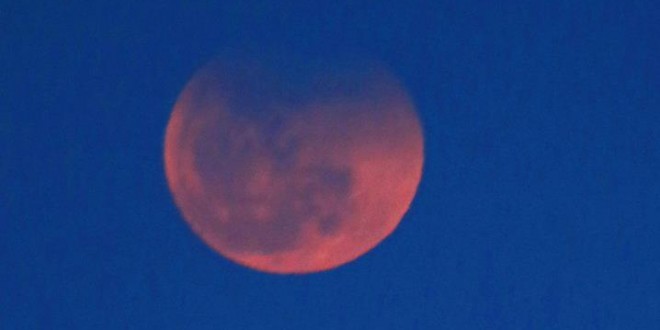On Wednesday, California and several other western states will witness a total lunar eclipse, the last eclipse in 2014. The eclipse will be visible with the naked eye. It will start at 1:15 a.m. and end at 6:33 a.m. Pacific time.
A lunar eclipse takes place when the moon passes through the center of Earth’s shadow. This happens only when the moon is full and aligned with the Earth and sun.
The first hint of Wednesday’s eclipse begins at 2:15 a.m. as Earth’s curved shadow begins snipping away at the east (left) edge of the moon.
With each passing minute, the moon buries itself deeper inside the shadow like a badger digging deeper underground until totally immersed inside the shadow by 3:25 a.m.
This marks the beginning of totality — the most colorful phase of the eclipse, even though no sunlight shines directly on the lunar terrain.
Rather, the copper colors of the fully eclipsed moon originate from sunlight filtering through the thin ring of sunrises and sunsets encircling the Earth. The atmosphere bends those colors into the shadow’s center.
Totality ends at 4:24 a.m., when the moon starts to emerge from the shadow. By 5:34 a.m., the eclipse is finished and the full moon once again glows a familiar charcoal gray.
Then on Oct. 23, the full moon will be transformed into a dark new moon hidden inside the azure glow of the afternoon sky. However, on this day the new moon will reveal itself by partially covering the sun.
This partial eclipse of the sun will be visible across most of North America.
The eclipse begins about 1:40 p.m., as the black curved outline of the new moon begins sliding in front of the sun’s right (west) side.
By 3 p.m., the autumn sunlight might feel noticeably cooler as more than 60 percent of the sun is draped. This marks mid-eclipse.
With each passing minute, more of the sun is revealed. The eclipse will end about 4:25 p.m.
Solar eclipses are fun to watch but viewing safety is critical.
Never look directly at the sun unless using certified solar viewing glasses. These block all of the sun’s dangerous ultraviolet, infrared and bright light.
Eclipse viewers are inexpensive and can be ordered online. earch under “purchase solar eclipse viewers.”
Also, never look at the sun through stacked sunglasses, dark-tinted glass, layers of gray film or clouds. Though the sun appears dimmer, eye-damaging radiation is not blocked. You can seriously damage your eyes before realizing it.
Besides solar viewers, simple methods exist to make pinhole boxes that permit safe viewing of a projected dim image of the sun. Search online under “observing solar eclipses safely” for instructions.
Mother Nature provides one of the best natural solar projectors. How? Stand beneath a leafy tree and notice the curved shapes that the eclipsed sun forms on the ground after light passes through small gaps in the overhead foliage. (These shapes are normally round, like the sun.) This technique performs best during mid-eclipse.
Agencies/Canadajournal
 Canada Journal – News of the World Articles and videos to bring you the biggest Canadian news stories from across the country every day
Canada Journal – News of the World Articles and videos to bring you the biggest Canadian news stories from across the country every day



